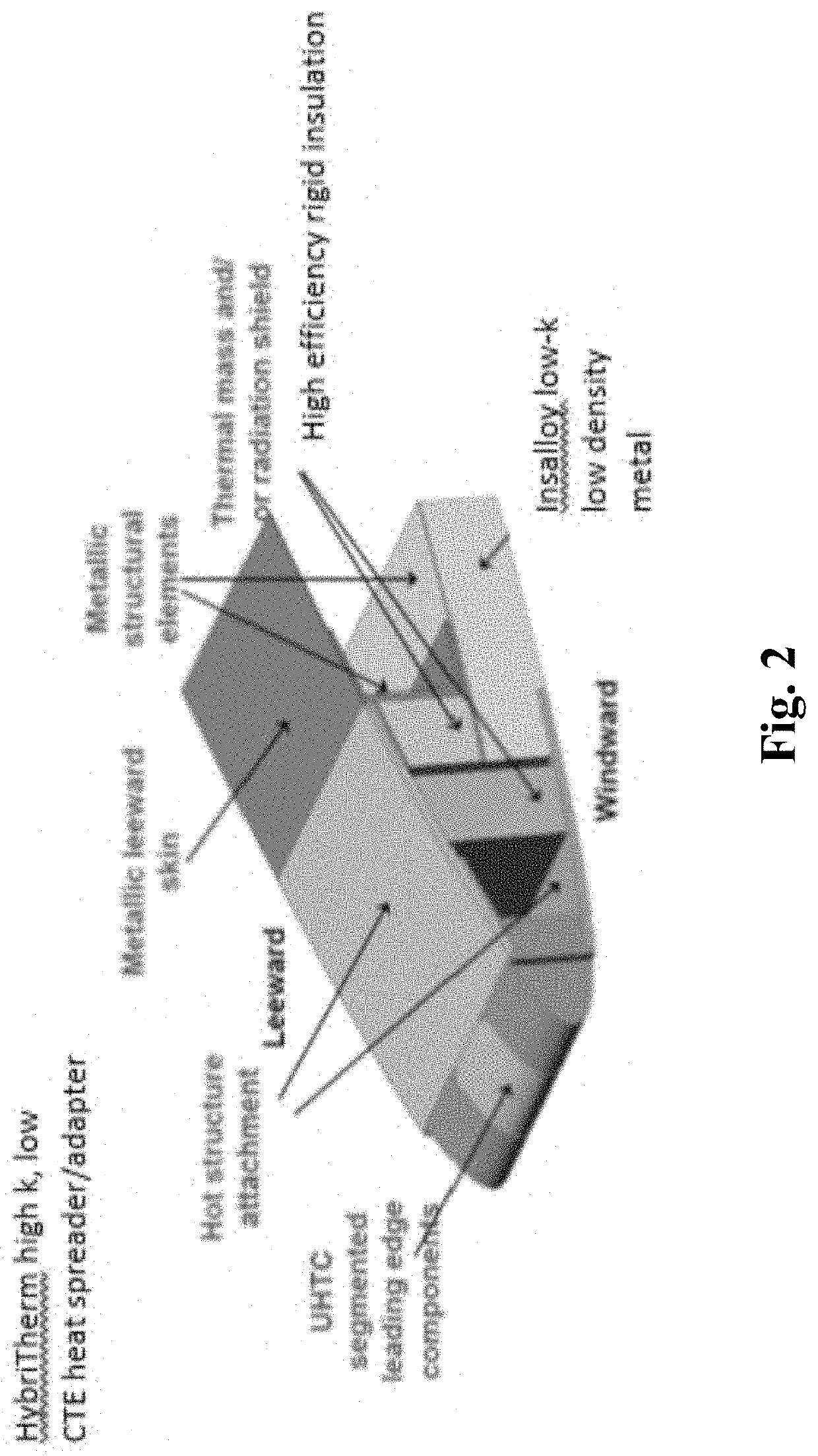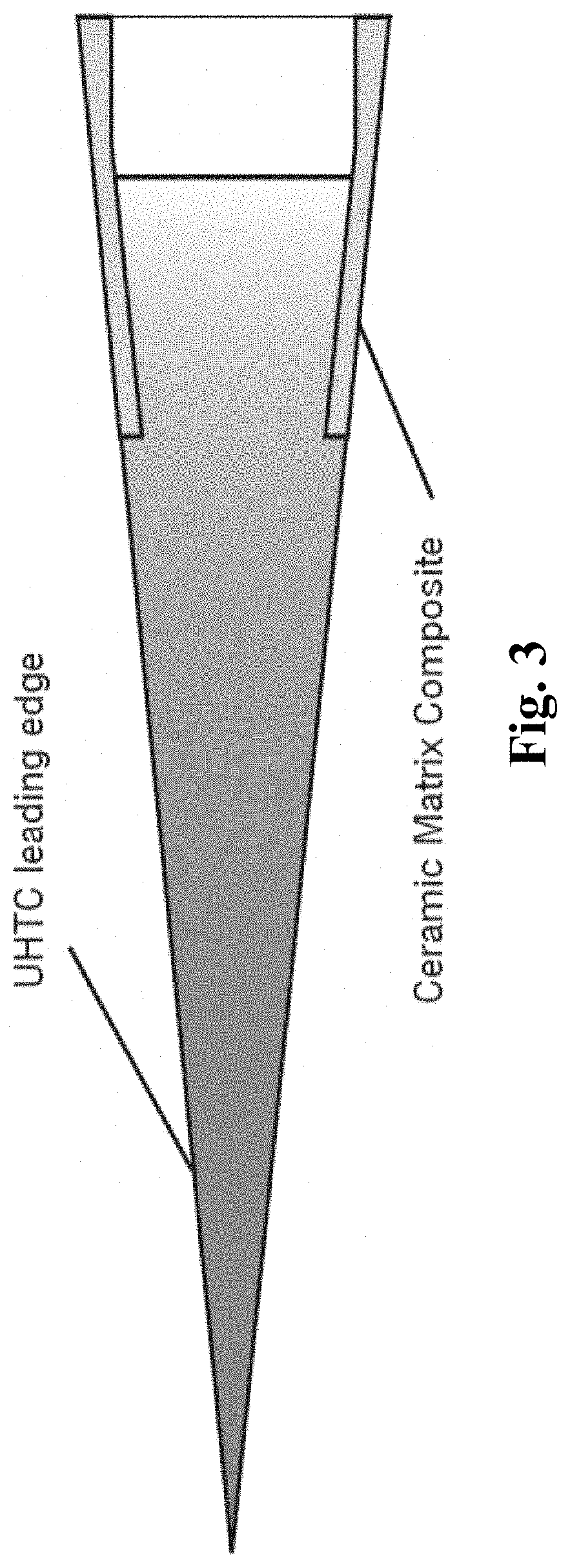Low Thermal Stress Engineered Metal Structures
a technology of engineered metal and low thermal stress, applied in metal-working apparatus, transportation and packaging, coatings, etc., can solve the problems of severe design constraints, large temperature changes of many structures of technological importance, and severe thermal stress of heat exchangers that undergo non-continuous use, so as to reduce overall system temperatures and/or control thermal stress. , the effect of dissipating thermal energy
- Summary
- Abstract
- Description
- Claims
- Application Information
AI Technical Summary
Benefits of technology
Problems solved by technology
Method used
Image
Examples
example 1
[0241]A high speed vehicle airframe panel was designed using a ceramic leading edge insert and an insulating structure. A thermal transition piece is fabricated from a BN-filled FeCrAlY, in the structure illustrated in FIG. 1 or 2 or 3. The HybriTherm thermally-engineered attachment structure includes a MA956 alloy (37-57 wt. % iron, 16-23 wt. % chromium, 2-7 wt. % aluminum, 0-1 wt. % titanium, 0-1 wt. % copper, 0-1 wt. % manganese, 0-1 wt. % cobalt, 0-1 wt. % nickel, 0-1 wt. % Y2O3, <0.2 wt. % carbon) multi-phase composite that is fabricated by premixing 40 vol. % of 60 micron D50 spheroidized BN fillers (boron nitride), which possess a 80-92 wt. % increase (and all values and ranges therebetween) addition of nickel coating by a solution based adsorption method, with 15-35 vol. % (and all values and ranges therebetween) (e.g., 25 vol. %) of 1-10 micron powder (and all values and ranges therebetween) mixture of 70-80 wt. % iron (and all values and ranges therebetween) (e.g., 75.5 wt...
example 2
[0242]A multi-phase composite panel was fabricated using powder metallurgy processing from Hastelloy-N (e.g., 68-73 wt. % nickel, 5-8 wt. % chromium, 14-18 wt. % molybdenum, <0.2 wt. % carbon, <0.5 wt. % cobalt, <0.5 wt. % copper, 0-1 wt. % tungsten, <0.6 wt. % aluminum, <0.6 wt. % titanium) and alloy powders using the sequence described in Example 1, but sintered at 950-1200° C. (and all values and ranges therebetween) (e.g., 1080° C.). The material was fabricated into thin sheets, which were alternately etched with complex channels. The solid panels and machined panels were stacked and spark plasma bonded into a solid core of a heat exchanger. The material demonstrates a 400-500% increase (and all values and ranges therebetween) in thermal conductivity compared to its parent metal, Hastelloy-N. Additional property modifications include a 65-90% reduction (and all values and ranges therebetween) reduction in modulus, a 5-15% reduction (and all values and ranges therebetween) in ...
example 3
[0243]A magnesium multi-phase composite electronic box was fabricated by melt infiltrating a calcium-modified AZ61 alloy containing calcium and cerium (85-92 wt. % magnesium, 5.80-7.2 wt. % aluminum, 0.4-1.5 wt. % zinc, up to 0.15 wt. % manganese, up to 0.1 wt. % silicon, up to 0.05 wt. % copper, up to 0.005 wt. % nickel, up to 0.005 wt. % iron, up to 2 wt. % calcium, up to 1 wt. % cerium, up to 1.5 wt. % graphene platelets) into a 35-50 vol. % (and all values and ranges therebetween) (e.g., 40 vol. %) spheroidized BN filler preform space using prealloyed AZ61 (88-92 wt. % magnesium, 5.80-7.2 wt. % aluminum, 0.4-1.5 wt. % zinc, up to 0.15 wt. % manganese, up to 0.1 wt. % silicon, up to 0.05 wt. % copper, up to 0.005 wt. % nickel, up to 0.005 wt. % iron)+titanium powders applied (blended) to the fillers using squeeze casting. The 2″ thick billets were extruded into a complex finned profile for use as heat sinks in electronic boxes.
PUM
| Property | Measurement | Unit |
|---|---|---|
| Temperature | aaaaa | aaaaa |
| Temperature | aaaaa | aaaaa |
| Fraction | aaaaa | aaaaa |
Abstract
Description
Claims
Application Information
 Login to View More
Login to View More - R&D
- Intellectual Property
- Life Sciences
- Materials
- Tech Scout
- Unparalleled Data Quality
- Higher Quality Content
- 60% Fewer Hallucinations
Browse by: Latest US Patents, China's latest patents, Technical Efficacy Thesaurus, Application Domain, Technology Topic, Popular Technical Reports.
© 2025 PatSnap. All rights reserved.Legal|Privacy policy|Modern Slavery Act Transparency Statement|Sitemap|About US| Contact US: help@patsnap.com



